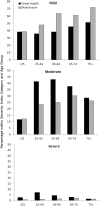Multimorbidity in a marginalised, street-health Australian population: a retrospective cohort study
- PMID: 25138806
- PMCID: PMC4139644
- DOI: 10.1136/bmjopen-2014-005461
Multimorbidity in a marginalised, street-health Australian population: a retrospective cohort study
Abstract
Objectives: Demographic and presentation profile of patients using an innovative mobile outreach clinic compared with mainstream practice.
Design: Retrospective cohort study.
Setting: Primary care mobile street health clinic and mainstream practice in Western Australia.
Participants: 2587 street health and 4583 mainstream patients.
Main outcome measures: Prevalence and patterns of chronic diseases in anatomical domains across the entire age spectrum of patients and disease severity burden using Cumulative Illness Rating Scale (CIRS).
Results: Multimorbidity (2+ CIRS domains) prevalence was significantly higher in the street health cohort (46.3%, 1199/2587) than age-sex-adjusted mainstream estimate (43.1%, 2000/4583), p=0.011. Multimorbidity prevalence was significantly higher in street health patients <45 years (37.7%, 615/1649) compared with age-sex-adjusted mainstream patients (33%, 977/2961), p=0.003 but significantly lower if 65+ years (62%, 114/184 vs 90.7%, 322/355, p<0.001). Controlling for age and gender, the mean CIRS Severity Index score for street health (M=1.4, SD=0.91) was significantly higher than for mainstream patients (M=1.1, SD=0.80), p<0.001. Furthermore, 44.2% (530/1199) of street health patients had at least one level 3 or 4 score across domains compared with 18.3% (420/2294) for mainstream patients, p<0.001. Street health population comprised 29.6% (766/2587) Aboriginal patients with 50.4% (386/766) having multimorbidity compared with 44.6% (813/1821) for non-Aboriginals, p=0.007. There were no comprehensive data on Indigenous status in the mainstream cohort available for comparison. Musculoskeletal, respiratory and psychiatric domains were most commonly affected with multimorbidity significantly associated with male gender, increasing age and Indigenous status.
Conclusions: Age-sex-adjusted multimorbidity prevalence and disease severity is higher in the street health cohort. Earlier onset (23-34 years) multimorbidity is found in the street health cohort but prevalence is lower in 65+ years than in mainstream patients. Multimorbidity prevalence is higher for Aboriginal patients of all ages.
Keywords: PRIMARY CARE; chronic disease; multimorbidity.
Published by the BMJ Publishing Group Limited. For permission to use (where not already granted under a licence) please go to http://group.bmj.com/group/rights-licensing/permissions.
Figures





References
-
- Barnett K, Mercer SW, Norbury M, et al. Epidemiology of multimorbidity and implications for health care, research, and medical education: a cross-sectional study. Lancet 2012;380:37–43 - PubMed
Publication types
MeSH terms
LinkOut - more resources
Full Text Sources
Other Literature Sources
Medical
